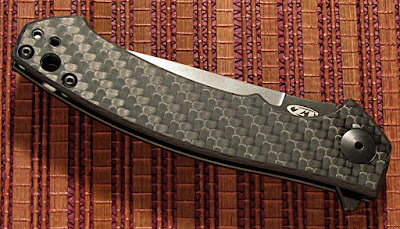Ah…Belarus, a small Eastern
European landlocked country best known for its Stalinist architecture and grand
fortifications. If you’re stopping for a
tour, make sure you visit KGB Headquarters looming over Independence Square and
the many Great Patriotic War monuments commemorating the country’s role in WWII.
Sounds bleak, doesn’t? Especially the tour of KBG headquarters which
could last 20 to 30 years.
 |
| I really like the carbon fiber handle. |
From this country comes Dmitry
Sinkevich, knife maker and artist. His
knife designs are snapped up by companies like Spyderco and Zero Tolerance. It only takes a simple look to see why.
Let’s look at his design, the ZT
450CF for example. The knife sports a
3.25 inch slice of CPM S35VN. More on
this steel later. The blade is a saber
grind, drop point with a long false edge and flipper. The blade glides open on KVT ball
bearings. The front of the handle is
carbon fiber and backed with titanium.
 |
| The clip is reversible and provides a relatively low profile look when pocketed. |
This makes for a very trim and
graceful knife weighing in at 2.45 ounces.
The lock mechanism is a standard
frame lock, but because titanium can’t be hardened to the same values as steel,
the locking bar sports a small steel insert that serves two functions in
addition to locking the knife open. One,
it takes the wear of contacting the steel blade and two, acts as a stop to
prevent the bar from being pushed out beyond its elastic limits. The insert, in case you were wondering, is
replaceable.
 |
| The carbon fiber is striking. This is a very nice Gent's Knife. |
S35VN is martensitic steel which
contains 3% vanadium and 0.5% niobium in addition to chromium. All three elements are carbide formers, but
chemical properties favor the formation of vanadium and niobium carbides over
chromium. These two carbides are harder
and finer in size than chromium carbide and reinforce the steel more.
Tests by CPM indicate the steel has
better edge retention, less wear and more corrosion resistance than many steels
including 440C and D2.
 |
| I like the open back and the green spacers are just for fun and very cool. |
The knife is strikingly
impressive in my opinion. It fits my
hand and the blade flicks out on the KVT ball bearing. The knife is set up for tip-up carry and the
clip is reversible for left or right carry.
I can’t take it for a test run,
as it’s not mine to use. If ZT would
like to send me a writer’s sample, I’ll run some cutting tests and expand
this.
The Sinkevich ZT450CF is light,
trim and comfortable to use knife which is, bladed with a techno steel to give
you long life and edge retention.
Frankly, at the retail price of $245 it looks like a bargain.
Find yours at https://zt.kaiusaltd.com/knives/knife/zt0450cf



